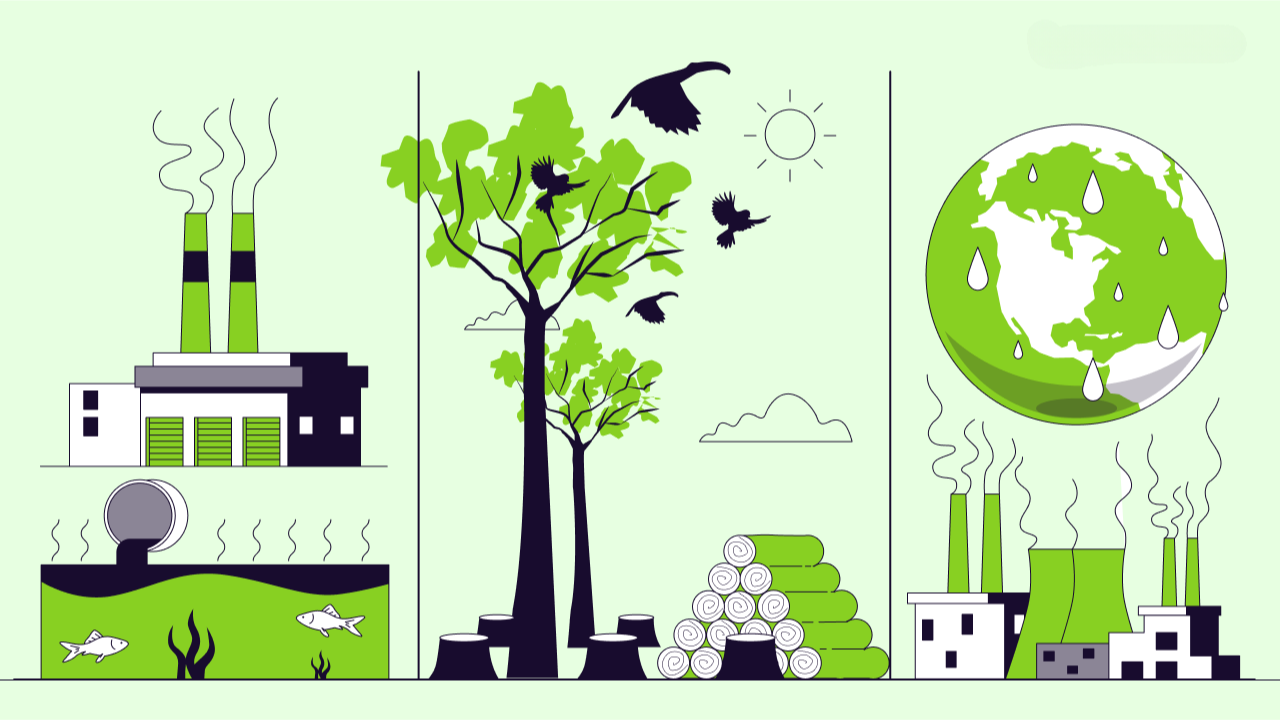Understanding carbon footprint and its importance for modern businesses
In a world experiencing rapid environmental change, carbon footprint has become more than just an environmental term; it has become a strategic indicator that measures the commitment of individuals and companies to sustainable practices. In fact, carbon footprint refers to the total amount of greenhouse gases emitted as a result of daily activities or operational processes. Therefore, paying attention to it is no longer a secondary option, but rather an absolute necessity for every organization aspiring to build a strong reputation and solid social responsibility.
It’s worth noting that companies today are no longer measured solely by their profits, but also by their commitment to sustainability and reducing emissions. Additionally, customers and investors are increasingly paying attention to companies that embrace genuine environmental initiatives. Therefore, reducing their carbon footprint not only contributes to protecting the planet, but also fosters trust and long-term relationships with the public.
Why is carbon footprint important in business?
Primarily, carbon footprint plays a major role in determining the impact of industrial and service activities on the environment. Moreover, Measuring it helps organizations develop clear strategies to reduce emissions and improve energy efficiency. On the other hand, ignoring this concept could lead to a loss of competitiveness, especially with the tightening of international laws and regulations related to sustainability.
In addition, organizations that invest in environmental sustainability initiatives reap tangible marketing benefits. When customers see that a company cares about the environment and seeks to reduce its carbon footprint, they feel more trust and loyalty. This commitment, in turn, becomes a driving force for growth and expansion, rather than merely a moral or legal obligation.
How does carbon footprint affect brand image?
In fact, reputation plays a pivotal role in any brand’s success. Therefore, when a company demonstrates a genuine interest in reducing emissions, it builds a positive image that distinguishes it from competitors. Moreover, Environmental initiatives help attract new customers, especially conscious consumers who prefer dealing with sustainable brands. Therefore, managing your carbon footprint has become an integral part of modern marketing strategies.
Moreover, it’s not just about reputation; it extends to improving operational efficiency as well. When a company develops plans to reduce energy consumption or minimize production losses, it ultimately lowers operating costs. Therefore, sustainability here doesn’t mean sacrificing profitability, but rather striking a smart balance between environmental responsibility and commercial success.
Methods for measuring carbon footprint and strategies for reducing it
In order to build an effective plan to reduce emissions, it’s essential to first understand how to accurately measure your carbon footprint. In fact, this step is the cornerstone of any successful sustainability strategy, as it helps organizations identify sources of emissions and identify areas for improvement. Furthermore, regular measurement provides reliable data that can be used to inform future decisions.
First: How to measure carbon footprint
Carbon footprints are typically measured by calculating the amount of carbon dioxide and other gases emitted from various activities. Therefore, emissions are divided into three main categories known as “emission ranges”:
- Scope 1: Includes direct emissions from the company’s own operations, such as fuel used in factories or private transportation.
- Scope 2: relates to indirect emissions resulting from the consumption of electricity and energy purchased from external sources.
- Scope 3: This is the broadest, covering emissions from the supply chain, including suppliers, customers, and waste.
Interestingly, many organizations previously focused only on Scopes 1 and 2. However, today it’s essential to consider Scope 3 as well, as it often represents the largest portion of overall emissions. Therefore, accurate and comprehensive measurement provides a clearer view and sets the organization on a path to continuous improvement.
Second: Effective strategies to reduce the carbon footprint
After identifying emission sources, the next stage is to take action to reduce them. Therefore, organizations must adopt realistic, gradual strategies that ensure tangible results in the short and long term.
The most prominent of these strategies are:
- Switching to renewable energy:
This step is one of the most impactful solutions. When a company relies on solar or wind energy instead of fossil fuels, it significantly reduces its emissions. Additionally, it can benefit from government incentives that encourage the use of clean energy sources.
- Improve energy efficiency:
In addition to switching to renewable energy, emissions can be reduced by improving energy use in buildings and equipment. For example, Replacing traditional light bulbs with LED bulbs or upgrading your heating and cooling systems can significantly reduce your carbon footprint.
- Waste Management and Recycling:
In fact, waste management is one of the most important factors affecting emissions. Therefore, adopting recycling and waste reduction policies has a positive impact on the environment and demonstrates an organization’s commitment to the principles of a circular economy.
- Improving transportation and logistics services:
Since transportation accounts for a significant percentage of emissions, using electric vehicles or relying on environmentally friendly transportation can make a significant difference. Furthermore, transportation efficiency can be improved by shortening distances or consolidating shipments.
- Education and building internal awareness:
It’s important for all employees to be aware of the concept of carbon footprint and their role in reducing it. Therefore, organizing workshops and training programs contributes to creating a culture of sustainability within the organization, making environmental efforts more sustainable.
Transforming to a sustainable business model
On the other hand, the impact of reducing the carbon footprint is not limited to the environmental aspect, but extends to economic and social aspects. When a company adopts a sustainable business model, it becomes more able to adapt to regulatory and climate changes. Therefore, this transformation not only protects the environment but also enhances the organization’s flexibility and ability to compete in global markets.
Moreover, Organizations that start early on this path are always in a pioneering position. They don’t wait for laws or external pressures to impose themselves, but rather lead the change themselves. Therefore, investing in reducing the carbon footprint is an investment in the future, whether economically, environmentally, or socially.
Reins’ role in supporting organizations towards a sustainable future
In light of the environmental challenges facing the world today, the need for a trusted partner to lead organizations toward sustainability has become unavoidable. This is where Reins comes in, providing smart solutions to reduce carbon footprints and support organizations in their green transformation journey.
In fact, Reins does not limit itself to providing general environmental consulting, but rather relies on a comprehensive and integrated approach that begins with analyzing current environmental performance and extends to developing practical, implementable strategies. Moreover, The company designs customized solutions for each client, as each organization has its own unique footprint and different operational needs.
Reins services to reduce carbon footprint
To achieve real and sustainable results, Reins offers a diverse range of services that help transform environmental commitment into a strategic advantage. These services include:
- Carbon emissions analysis and assessment:
Reins’ specialized teams thoroughly assess all emission sources within the organization, enabling the client to understand weaknesses and set improvement priorities. In addition, detailed reports are prepared to facilitate management’s decision-making based on clear data.
- Developing sustainability strategies:
After the analysis phase, Reins develops a comprehensive plan to gradually and continuously reduce its carbon footprint. This strategy includes setting time-bound targets and implementing realistic solutions such as switching to renewable energy or improving operational efficiency.
- Rehabilitation and capacity building:
On the other hand, Sustainability cannot be achieved without human engagement. Therefore, Reins provides practical training programs aimed at raising environmental awareness and fostering a culture of sustainability within the organization. As a result, employees become an active part of the process of positive change.
- Internationally accredited reports and consultations:
At the same time, Reins helps organizations prepare sustainability reports that comply with international standards such as the GHG Protocol and ISO 14064. This ensures transparency and credibility for customers and investors alike.
Why choose Reins?
Choosing Reins doesn’t just mean partnering with a consulting firm, but rather with a team of experts who understand environmental challenges from a practical and strategic perspective. Additionally, the company combines deep technical expertise with the ability to innovate to deliver measurable solutions with a tangible impact.
It’s worth noting that organizations that work with Reins not only fulfill their environmental commitments, but also gain a strong competitive advantage in the market. Every step toward reducing their carbon footprint translates into a distinct brand image, increased customer confidence, and improved long-term financial performance.
The transition to sustainability begins now.
The future certainly belongs to organizations that take serious steps toward positive environmental change. Therefore, starting today to assess and reduce your carbon footprint is no longer a luxury, but a strategic necessity. Moreover, Delaying this process could mean missing out on significant growth opportunities in a market rapidly moving toward a green economy.
For this reason, Reins invites all organizations to be part of this global transformation. With the help of the company’s experts, any organization can move from awareness to actual implementation, and then to leadership in the field of sustainability. Therefore, every decision you make today to reduce your carbon footprint is an investment in a brighter and safer future.












